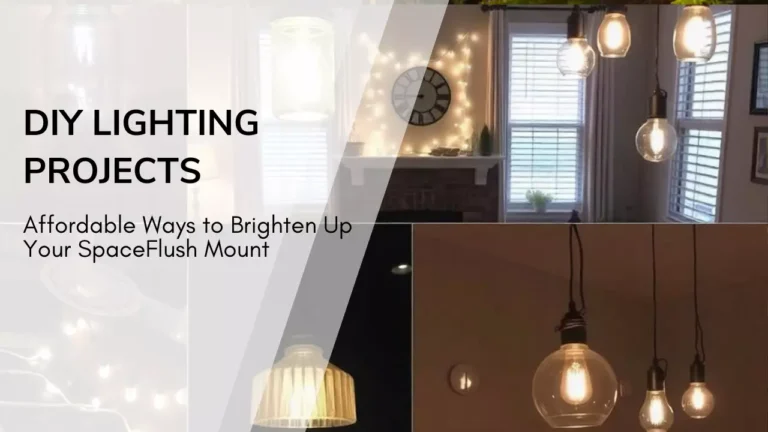How to Choose the Perfect Lighting for Your Living Room: A Complete Guide
Creating the perfect lighting for your living room can transform the ambiance of the space, elevate your decor, and even improve your daily living experience. Whether you’re relaxing with a book or hosting a movie night, your lighting choices play a significant role in setting the mood. This Living Room Lighting Guide will walk you through everything you need to know, from choosing the right fixtures to balancing natural and artificial light.
Understanding the Role of Lighting in Your Living Room
1. Setting the Mood with Lighting
Lighting is not just about visibility; it’s about creating the right atmosphere. Your living room can serve multiple purposes, from a cozy space for family gatherings to an elegant area for entertaining guests. The right lighting can set the tone for each activity.
Using dimmer switches can give you the flexibility to adjust the intensity of the light. For a quiet evening, you may want softer lighting, whereas a bright, lively party might need stronger illumination.
2. The Importance of Layering Light
When designing your living room lighting, think in layers. Using only one type of light can leave the room feeling flat. There are three main layers to consider: ambient lighting, task lighting, and accent lighting.
- Ambient Lighting: This is the main source of light, typically from ceiling fixtures or recessed lighting. It provides general illumination for the room.
- Task Lighting: For focused activities like reading or knitting, task lighting comes into play. This includes table lamps or floor lamps placed in key locations.
- Accent Lighting: Accent lights highlight specific features like artwork or architectural elements, adding depth and interest to your space.
By combining all three, you can create a balanced and functional lighting design.
Types of Living Room Lighting Fixtures
3. Ceiling Fixtures: The Foundation of Your Living Room Lighting
Ceiling fixtures serve as the primary source of ambient lighting. The most common types include chandeliers, pendant lights, and flush mounts. These lights are typically installed in the center of the room to provide even illumination.
- Chandeliers: If you want to make a statement, a chandelier can add a touch of elegance and drama. Consider the size of your living room before choosing a chandelier; a small room might feel overwhelmed by a large fixture.
- Pendant Lights: Pendant lights offer a more modern and sleek look. They can hang above a coffee table or be spaced strategically across the ceiling for a more spread-out effect.
- Flush Mounts: For a more minimalistic design, flush mounts are a great option. They sit close to the ceiling, providing a clean and unobtrusive lighting solution.
Make sure your ceiling fixture matches the scale of your room and doesn’t overpower the space.
4. Table and Floor Lamps: Versatile Task Lighting
Table lamps and floor lamps offer flexibility, allowing you to move them around as needed. They can also serve as decorative pieces that add style to your living room.
- Table Lamps: These are ideal for placing next to sofas or chairs, providing focused lighting for activities like reading. Choose lamps that complement your room’s decor, whether modern, classic, or eclectic.
- Floor Lamps: Floor lamps are taller and can fill dark corners, adding height and dimension to your lighting scheme. Some floor lamps come with adjustable arms, making them great for multi-purpose lighting.
Be sure to choose lamps with shades that diffuse light, reducing harsh shadows and creating a soft glow.
Balancing Natural and Artificial Light
5. Maximizing Natural Light
Natural light is the best kind of light you can bring into your living room. It’s free, energy-efficient, and enhances the colors and textures in your space. To make the most of natural light, consider the following:
- Windows: Keep windows unobstructed by heavy curtains or furniture. Opt for sheer curtains to allow light in while maintaining privacy.
- Mirrors: Strategically placed mirrors can reflect natural light, making the room feel brighter and more spacious.
- Light-colored walls: Lighter paint colors reflect more light, helping to distribute natural sunlight throughout the room.
By optimizing natural light, you can reduce your reliance on artificial lighting during the day.
6. Combining Natural Light with Artificial Lighting
Even with plenty of windows, artificial lighting is essential once the sun goes down. When natural and artificial light work together, you create a harmonious and well-lit space. Consider how shadows fall and adjust your lighting to eliminate dark spots. Warm LED bulbs can mimic natural light, maintaining a cozy atmosphere in the evening.
Choosing the Right Light Bulbs
7. Understanding Light Bulb Types
Not all bulbs are created equal. The type of bulb you choose can affect the color and warmth of the light, as well as your energy usage. Here’s a breakdown of the most common light bulb types:
| Bulb Type | Pros | Cons |
|---|---|---|
| Incandescent | Warm light, affordable | Short lifespan, higher energy consumption |
| LED | Energy-efficient, long-lasting, versatile | Higher upfront cost, but saves in the long run |
| CFL | Energy-efficient, affordable | Takes time to warm up, contains mercury |
| Halogen | Bright, natural-looking light | Gets very hot, shorter lifespan than LEDs |
Choosing LED bulbs is often the best option for long-term savings and eco-friendliness. They come in various color temperatures, from cool to warm, so you can customize the mood of your living room.
8. Color Temperature Matters
The color temperature of your bulbs will greatly affect the feel of your room. Measured in Kelvin (K), it ranges from warm (yellow tones) to cool (blue tones).
- Warm Light (2700K-3000K): Ideal for living rooms where you want a cozy, relaxing atmosphere.
- Neutral Light (3500K-4100K): Offers a more natural feel, great for tasks and overall illumination.
- Cool Light (5000K-6500K): Mimics daylight, which can feel too harsh for living rooms, but is good for task-oriented areas.
Consider what activities you plan for your living room to choose the right color temperature.
Lighting Design Tips for Different Living Room Styles
9. Modern Living Room Lighting Ideas
Modern living rooms often feature clean lines and minimalistic decor. To complement this aesthetic, opt for sleek pendant lights, recessed lighting, and LED strips that provide subtle, indirect light. Accent lighting like LED strips along the base of furniture or behind the TV can add a futuristic touch.
Use a combination of task and accent lighting to emphasize focal points like art pieces or geometric furniture.
10. Traditional Living Room Lighting
In a traditional living room, chandeliers and floor lamps with ornate designs can complement rich wood tones and classic furniture. Opt for warm lighting to maintain the cozy, inviting feel of the space. Table lamps with fabric shades and bronze or brass finishes can also enhance the traditional aesthetic.
Layer your lighting by mixing chandeliers for ambient light and floor lamps for task lighting, keeping the look cohesive yet functional.
11. Rustic or Industrial Living Room Lighting
For rustic or industrial styles, choose lighting fixtures with materials like wood, metal, and exposed bulbs. Edison bulbs are a popular choice, offering a vintage feel that works well in these spaces. Pendant lights with industrial finishes and iron floor lamps add to the rugged charm.
The key is to maintain a balance between functionality and the raw, organic elements typical of rustic or industrial decor.
Common Living Room Lighting Mistakes to Avoid
12. Relying on a Single Light Source
One common mistake is relying on just one overhead light to illuminate the entire living room. This can create a harsh and unwelcoming environment, with shadows in the corners. Always layer your lighting with a combination of ambient, task, and accent lights to create a more comfortable and inviting space.
13. Ignoring the Scale of Your Fixtures
Another frequent mistake is choosing lighting fixtures that are too big or too small for the room. A fixture that’s too large can overwhelm the space, while one that’s too small may not provide enough light. Make sure to measure your room and select fixtures that fit the proportions properly.
Final Thoughts on Living Room Lighting
Lighting can make or break the look and feel of your living room. By using layers of light, choosing the right fixtures, and balancing natural and artificial light, you can create a living room that is not only beautiful but functional too.
When planning your lighting design, always consider the activities that will take place in the room and the mood you want to set. A well-lit living room enhances the overall atmosphere of your home, making it more enjoyable for both you and your guests.
For more on interior lighting tips, visit this resource on lighting design, or check out lighting guides for different room styles. You can also explore the benefits of LED bulbs to make energy-efficient choices for your home.







